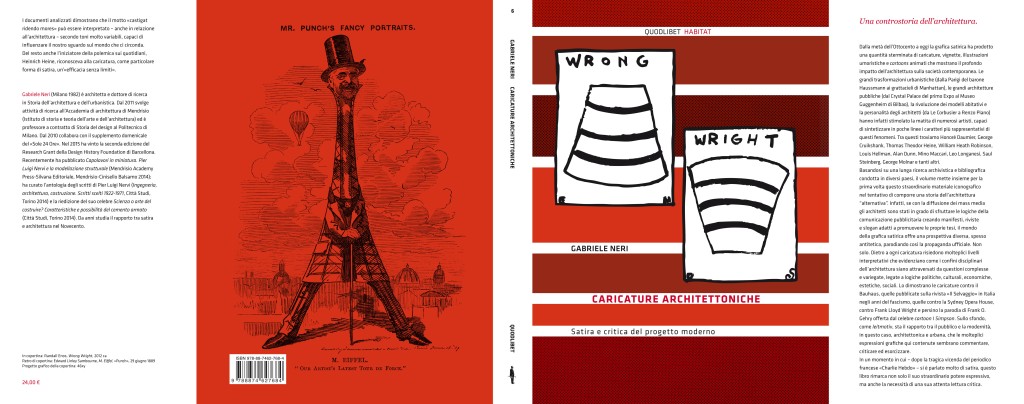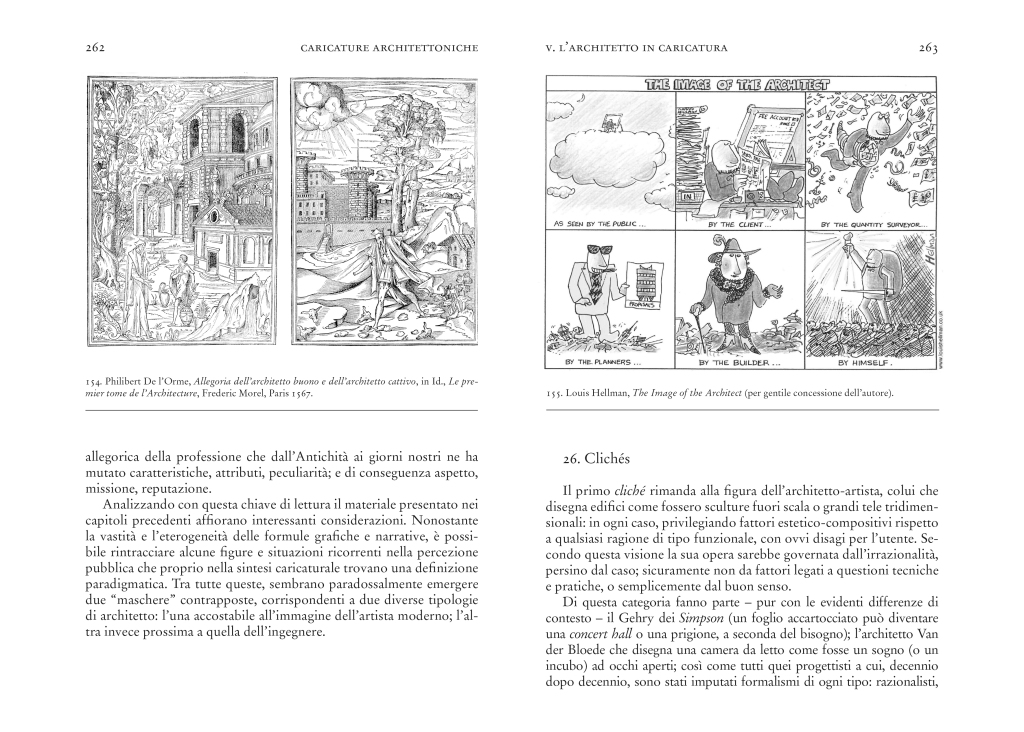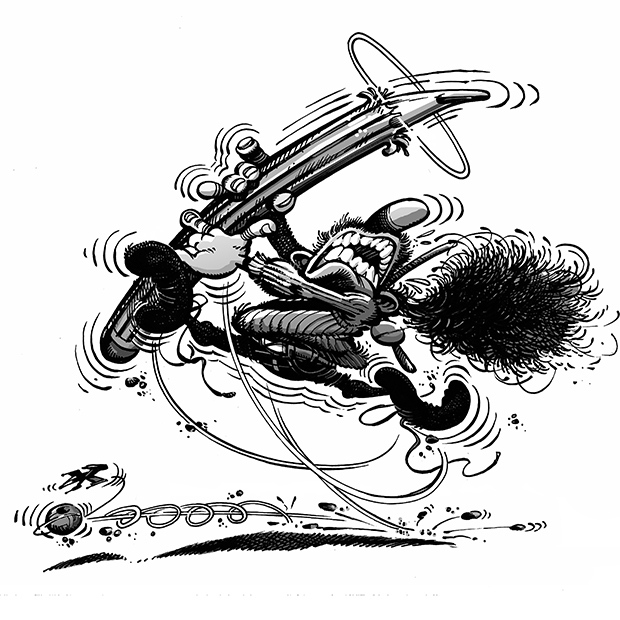
Second in this series of posts recovering stuff that I should be posted back in the day but never did is Gabriele Neri’s fantastic 2015 book Caricature architettoniche, Satira e critica del progetto moderno (Architectural caricatures. Satire and criticism of the modern project). Back in 2015, Gabriele contacted me and informed me about this project of his, where he reviewed the way in which both architecture and architects had been dealt with by newspaper and magazine cartoonists, starting with Honoré Daumier, and featuring a long strings of authors such as George Cruikshank, Thomas Theodor Heine, William Heath Robinson, Louis Hellman, Alan Dunn, Mino Maccari, Leo Longanesi, Saul Steinberg, and George Molnar among many others. For some inexplicable reason (he was young and naive, I guess), Gabriele thought my work merited some place in the book, and was so kind as to ask me for a couple of pieces to reproduce in it, and also subsequently sent me a couple of copies of the handsome volume for my personal archive.

The beautiful over and back cover design by 46xy , featuring Randall Enos’s ‘Wrong, Wright’, and Edward Linley Sambourne’s cartoon of Gustave Eiffel for Punch (June 29, 1889). Click to enlarge
The book is divided in 5 chapters, each dealing with a different topic: the first one, ‘Mass Architecture’, tackles the phenomenon of those architectural icons wich, for one reason or another, were prominently examined by the daily press, with spacial attention given to the Guggenheim Bilbao, Paxton’s Crystal Palace, and the painful development of Jorn Utzon’s Sydney Opera House. The second one, ‘The House’, features some delightful classics, such as those by W.H. Robinson, together with lesser-known examples of modern-housing-deprecation. After a third chapter devoted to the Italian case, chapter four, ‘The Modern City’, returns to the classics with passages devoted to Le Corbusier’s Ville Radieuse, ending with an Italian-American mixture: Topolinia (home city to Mickey Mouse, aka Topolino, in Italian-produced Disney comics). The fifth and final chapter, ‘The Architect in the Cartoon’ deals with the way in which architects have been depicted by cartoonists (sometimes by architect-cartoonists), and the stereotypes and cliches traditionally attached to them, with a final note dealing with starchitects. This is the section I’m featured in, and in the very good company of the legendary Louis Hellman, among other authors.

“It is worth paying attention to Klaus’s work, as he has been offering for some years (on his blog but not only) funny cartoons oscillating between the world of comics and that of the satirical cartoon, taking inspiration from current events. In fact, it is common to insert newspaper clippings inside of the strips, which act as a starting point for the drawn scene. For example, in one cartoon, Klaus starts with the scandal caused by the “analogies” between buildings and genital organs (Foster’s tower in London, similar to a vibrator; Zaha Hadid’s stadium for Qatar, seen by many as a vagina) to design a “museum of erotic architecture”, where photos and renderings of these projects are given a place of honor. “Form Follows Libido”, suggests Klaus, citing Sylvia Lavin’s study.” Click to enlarge.

[The published cartoon is “Form Follows Friction (Aka Za ha ha… Did I?)” (Numerus Klausus no. XI, Uncube magazine, 17 December 2013), which included cameos from -a very poorly cartoonized- Sophie Lovell, Jean Nouvel Sigmund Freud, and, of course Sylvia Lavin and Greg Lynn [Some comments on it here]. Click to enlarge.
Once I got the book, I quickly went through it, reading it from cover to cover and enjoyed it thoroughly. I also took extensive notes, intending to write a review for a journal. Then, something else came in my way, and never did. So, given I have now some projects with Gabriele in the pipeline, I thought this provided me enough of a excuse to dust off this post, which has been waiting in the ‘draft’ section of this blog for almost a decade. I don’t have my notes with me now (and, honestly, I don’t know if I would be able to write a review that did justice to Gabriele’s work at this time), so let the following blurb, borrowed from the book’s publisher, Quodlibet’s site, work as a suitable tribute:
Caricature architettoniche – Satira e critica del progetto moderno
From the mid-nineteenth century to today, satirical graphics have produced an endless quantity of caricatures, cartoons, humorous illustrations and animated cartoons that show the profound impact of architecture on contemporary society. The great urban transformations (from Baron Haussmann’s Paris to the skyscrapers of Manhattan), the great public architecture (from the Crystal Palace of the first Expo to the Guggenheim Museum in Bilbao), the revolution in housing models and the personality of architects (from Le Corbusier to Renzo Piano) have in fact stimulated the pencil of numerous artists, capable of summarizing in a few lines the most representative characteristics of these phenomena. Among these we find Honoré Daumier, George Cruikshank, Thomas Theodor Heine, William Heath Robinson, Louis Hellman, Alan Dunn, Mino Maccari, Leo Longanesi, Saul Steinberg, George Molnar and many others.

Chapter 2: The House: A rainy night inside one of the new siedlungen…

… and a couple digs at Gaudí’s Milá House (the one on the right has been my favorite cartoon from this period for many years).
Based on extensive archival and bibliographic research conducted in various countries, the volume brings together this extraordinary iconographic material for the first time in an attempt to compose an “alternative” history of architecture. In fact, if with the spread of mass media architects have been able to exploit the logic of advertising communication by creating posters, magazines and slogans suitable for promoting their theses, the world of satirical graphics offers a different, often antithetical, perspective, thus parodying official propaganda. Not only. Behind each caricature lie multiple interpretative levels which highlight how the disciplinary boundaries of architecture are crossed by complex and varied issues, linked to political, cultural, economic, aesthetic and social logics. This is demonstrated by the caricatures against the Bauhaus, those published in the magazine «Il Selvaggio» in Italy during the years of fascism, those against the Sydney Opera House, against Frank Lloyd Wright and even the parody of Frank O. Gehry offered by the famous cartoon The Simpsons . In the background, as a leitmotif , lies the relationship between the public and modernity, in this case, architectural and urban, which the multiple graphic expressions contained here seem to comment on, criticize and exorcise.

The Modern -and contemporary- City and its discontents (Chapter 4), via Zaha, Libeskind, Isozaki, and Rubens.
At a time when – after the tragic story of the French periodical “Charlie Hebdo” – there has been a lot of talk about satire, this book highlights not only its extraordinary expressive power, but also the need for its careful critical reading. The documents analyzed demonstrate that the motto “castigat ridendo mores” can be interpreted – also in relation to architecture – according to very variable tones, capable of influencing our gaze on the world around us. Moreover, even the initiator of the newspaper controversy, Heinrich Heine, recognized caricature, as a particular form of satire, with “limitless effectiveness”.

Hellman’s ‘The Image of the Architect’ in Chapter Five: The Cartoon Architect…

…and some more Hellman goodness in the form of his Archi-Têtes (The Id in the Grid).
Gabriele Neri: Caricature architettoniche; Satira e critica del progetto moderno. Quodlibet, 2015. ISBN: 9788874627684, 320 pp.

Leave a comment